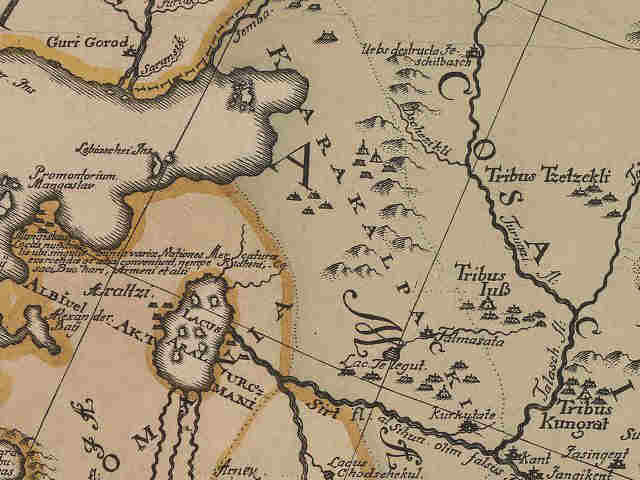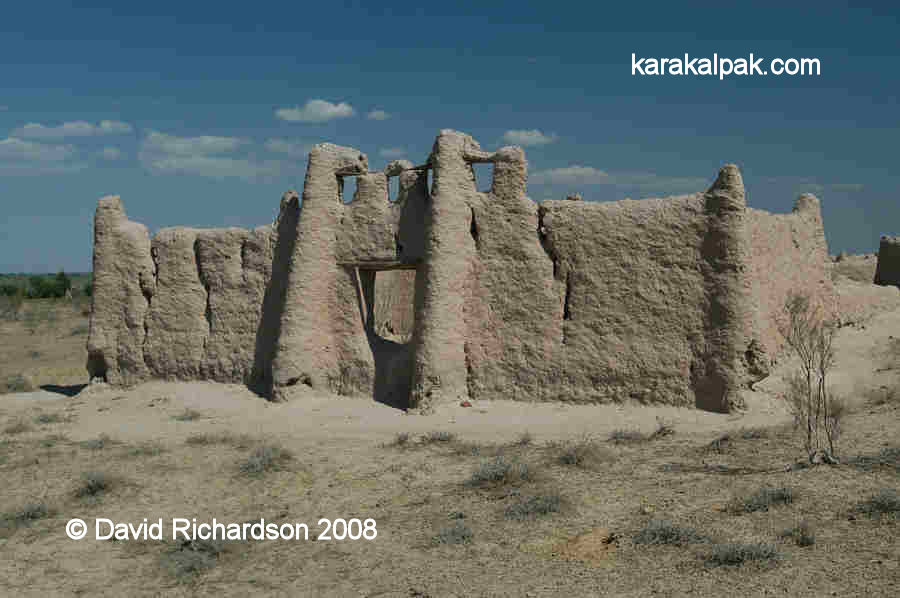|
This is a Temporary Page
Satellite image of the Aral region, showing the old dried-up channel of the Jan'a Darya
forking right from the Syr Darya towards the Amu Darya delta
Image courtesy of MODIS Rapid Response Project at NASA's Goddard Space Flight Center
The very first historical reference to the Karakalpaks occurs in a deed for a mausoleum at Sighnaq, issued by the Khan of Bukhara in 1598, which
mentions that they were one of the nomadic tribes living in the area. Sighnaq was on the south bank of the Syr Darya between modern Turkestan and
Qizil Orda. Karakalpaks were involved with Qazaqs in riots and raids on Bukhara during the reign of Khan Baki Muhammad (1599-1605) and Abu'l Ghazi
tells us that the Khiva Khan Habash escaped to the Karakalpaks on the banks of the Syr Darya in the 1620s. Russian documents show that Karakalpaks
fought in the Khan of Bukhara's army and were also present in the lower Syr Darya. Karakalpaks were reported living in the vicinity of Cossacks
just outside one of the cities "three days from Turkestan", on the middle Syr Darya just before 1700. It was noted that they had many sheep and
horses, a few cows and were involved in some light agriculture.
At around the same time Russian documents from the 17th century refer to joint military operations between Karakalpaks and Noghays on the Ural and
point to Karakalpaks in the upper reaches of the Ural and Emba rivers. In the early 17th century the Karakalpaks were closely linked to the Noghays
and they were raiding the cities of Siberia together. In 1690 and 1691 Karakalpaks participated in attacks on a stockaded town in the Tyumen region of
western Siberia and on settlements along the river Tobol.
During the 1660s the Tsar issued instructions for the mapping of Siberia. However, it was not until around 1696 that Semen Remezov from Tobolsk
mapped the location of the various Siberian tribes in the region along with their southern neighbours, presenting them to the Tsar in the form of a
"Sketch Book of Siberia" containing 23 maps. One of these maps identifies Karakalpak nomads on the Syr Darya to the east of the Aral Sea as well as
between the northern part of the Aral Sea and the northern Caspian. Araltsy, or Aral Uzbeks are shown around the coast of the Aral and on some of
its islands. In 1717 we know that Karakalpaks attacked Prince Bekovich just after he set off for Khiva from Guryev on the north coast of the
Caspian. A little later in 1730 the Swedish cartographer Philip Johann von Stralenberg, a prisoner of war in Tobolsk, published a map of Russia
which showed Karakalpaks occupying the region between the Emba River and the middle Syr Darya and to the north of the Caspian and Aral Seas.

|
Detail from Philip Johann von Strahlenberg's "Nova descriptio geographica Tattariae magnae" published in 1730.
It shows Karakalpaks living from the mouth of the Emba and north of the Aral Sea and the lower and middle Syr Darya.
From Göttingen State University Library, Germany.
During the last ten years archaeologists from the Karakalpak Branch of the Academy of Sciences in No'kis have been studying Karakalpak burial
constructions at Qalmaq qala on the Qırantaw elevation, situated on the right bank of the Amu Darya downstream from Xojeli. The Karakalpaks built
distinctive walled enclosures around their burial sites and these evolved over time from simple rectangular structures to buildings resembling small
fortresses, with corner towers, castellated walls and gateways. The earliest structures date from the 17th century, showing that the Karakalpak
confederation had already expanded south as far as the Amu Darya delta by this early date.
An example of one of the later Karakalpak burial enclosures at Qırantaw.
It is clear that the formation of the Karakalpak tribal confederation occurred prior to 1600, probably over a large geographical area. By the start
of the 17th century it had effectively become divided into two groups, the majority concentrated in the wetlands of the lower and middle Syr Darya
and the rest living on the banks of the Volga, Ural, and Emba rivers. The latter group were responsible for raiding the Russian outposts. During
the 17th century the confederation had reached as far south as Khorezm.
The origin of the Karakalpaks remains a contentious issue, especially in modern Karakalpakstan where ethnographers are keen to prove that the
Karakalpaks are the descendants of the original marsh dwelling Apasiak and Pecheneg settlers in the Amu Darya delta and are therefore its rightful
inheritors, unlike the "Johnny come lately" Uzbeks. Their theory is that having been forced out of the delta during the 15th century Aral Crisis,
the Karakalpaks simply returned to their homeland during the 17th and 18th. Although this idea may be partially correct it is far from the full story.
In reality the Karakalpaks emerged from the whole mêlée of intermingling clans and tribes across the Qipchaq Steppes that made up the Noghay,
Uzbek and Qazaq Hordes. There are very close similarities between the Karakalpak, Noghay and Qazaq languages, which all belong to the Qipchaq
language group and have clear links to the Pecheneg, Oghuz and Bulghar languages.
The Karakalpaks are organized into two unions or arıs: the On To'rt Urıw (meaning fourteen urıw or clans) and
the Qon'ırat, the former mainly engaged in settled irrigated agriculture, the latter in fishing and cattle-breeding. Each arıs
has its own oral legends containing hints about its past. The On To'rt Urıw has a legend telling how they moved to the Crimea after being
evicted from Khorezm following the Mongol invasion. Two hundred years later they gradually migrated eastwards, through the Volga, the Ural and the
Jan'a Darya, eventually reaching the Syr Darya. References to Noghay Khans such as Edigu, Orus and Ormanbet suggest a strong past association with
the Noghay Horde, which was an extremely loose confederation composed of many Turkic tribes whose origins go back to the earlier Pecheneg, Oghuz, and
Qipchaq nomads and probably included Mongolian elements derived from both the Qara Qitay and the Mongols.
Our best guess is that the Karakalpak confederation formed at some time after the fragmentation of the Golden Horde and involved tribes belonging to
the Noghay, Shaybani and other Hordes, along with groups already residing in the lower Syr Darya, Jan'a Darya and northern Khorezm regions. Following
the evacuation of many White Horde tribes to Russia many of these tribes, including some but not all of the Karakalpaks, progressively moved
eastwards along the Syr Darya during the 16th century to occupy their vacated lands. The Qon'ırat have a legend that they came to Khorezm
from the country of Zhideli Baysun, located in the south of present-day Uzbekistan. This suggests that they had travelled south from the Syr Darya
with the Shaybani Horde in the early 16th century. The reality is that the Karakalpak (just like the Uzbeks and Qazaqs) are a cocktail of many
tribes , some of whom once originated in Khorezm, some of whom are descendants of the earlier inhabitants of the middle Syr Darya – the Qangli or
Kanga, and others who came from further afield like the Sarmatians and Qipchaqs.
The Qazaqs were completely nomadic and they roamed widely so that their herds could find grassland for the whole of the year. Although horses and
sheep predominated, they also kept cattle (which they valued highly) and camels, which were used to transport their possessions during their seasonal
migrations. However the lands watered by the lower Syr Darya were quite poor and the annual flood season turned them into a vast marshy swamp
covered with dense rushes, separated by winding channels and isolated islands. The Karakalpaks followed a different lifestyle, inherited from their
ancestors, based upon a semi-settled, semi-nomadic, mixed pastoral-agricultural economy. Although the Karakalpaks raised cattle for meat they only
grazed their livestock on pastures during the summertime. In the winter they had to use their agricultural by-products for forage: hay, wheat and
millet straw, ju'weri stems (sorghum) and cane. In the spring they used their cattle to till the land. Each clan would have a wintering
ground, qıslaw, and a summering ground, jazlaw, usually not too far apart. In the winter the yurts would be erected inside
a windbreak fence for protection, and another fenced enclosure would be built for the cattle. In the spring they would move their yurts to the
summering ground, close to the cultivated areas, allowing their herds to graze on the surrounding marshes and pastures. After cultivating the land
during the summer, the fodder would be harvested and moved to the wintering ground by bullock cart. However not every Karakalpak was a farmer.
Some specialized in fishing, a few seem to have become involved in lead extraction, making bullets and gunpowder to trade with the Qazaqs, and some
wealthier Karakalpaks were merchants, trading with the Aral Uzbeks, Khiva, Bukhara and even with Russia through Bashkir intermediaries.
To water their crops, the Karakalpaks built increasingly complicated irrigation systems, allowing fields to be flooded and then drained. Details of
canals and weirs built of clay and saxaul were first recorded by a Russian delegation led by Lieutenant Gladyshev when he visited the Karakalpak
territories in 1741.
During the 17th century the Karakalpaks were concentrated along the Syr Darya: from the middle Syr Darya to the east of Qizil Orda, with a fortress
at Sighnaq, to the lower Syr Darya including the Quwan Darya and Jan'a Darya tributaries, with the Aq Uzak fortress at Yangikent. Throughout this
period they remained subservient to, and paid tribute to, the Khans of the Qazaq Little Horde. However by the start of the 18th century some
Karakalpaks had already begun to filter south into northern Khorezm, where they became embroiled in the conflict between the Aral Uzbeks and the
Khivan Khan.
At the beginning of the 18th century attempts were being made to reunite the different Karakalpak populations located in Khorezm, the Zeravshan
Valley and elsewhere with the main body of so-called Turkestan Karakalpaks living in the "land of the fathers" along the Syr Darya. Sighnaq seems
to have been at the heart of this effort to establish links with all of the tribes. However this attempt at tribal unification was soon overcome
by events.
Visit our sister site www.qaraqalpaq.com, which uses the correct transliteration, Qaraqalpaq, rather than the
Russian transliteration, Karakalpak.
Return to top of page
Home Page
|
|




